Abstract
DL-2-Amino-4-phosphonobutyric acid (APB) suppresses activity in retinal ON pathways. It is generally assumed that loss of the ON pathway would result in loss of ON responses in the visual system. We tested this assumption by recording activity from the optic nerves of intact goldfish (Carassius auratus) before and after intraocular injection of APB. Whole-nerve responses to increments and decrements of light were compared to electroretinogram responses and to tectal evoked potentials. APB severely reduced the amplitude of the electroretinogram b-wave but left ON and OFF responses from the optic nerve and tectum intact, although decreased in sensitivity. We conclude that APB does not completely eliminate ON responses in the visual system, at least in goldfish. The selectivity and effectiveness of APB must be evaluated in other species before this agent can be relied upon as a useful tool in understanding the roles of ON and OFF pathways in visual function.
Full text
PDF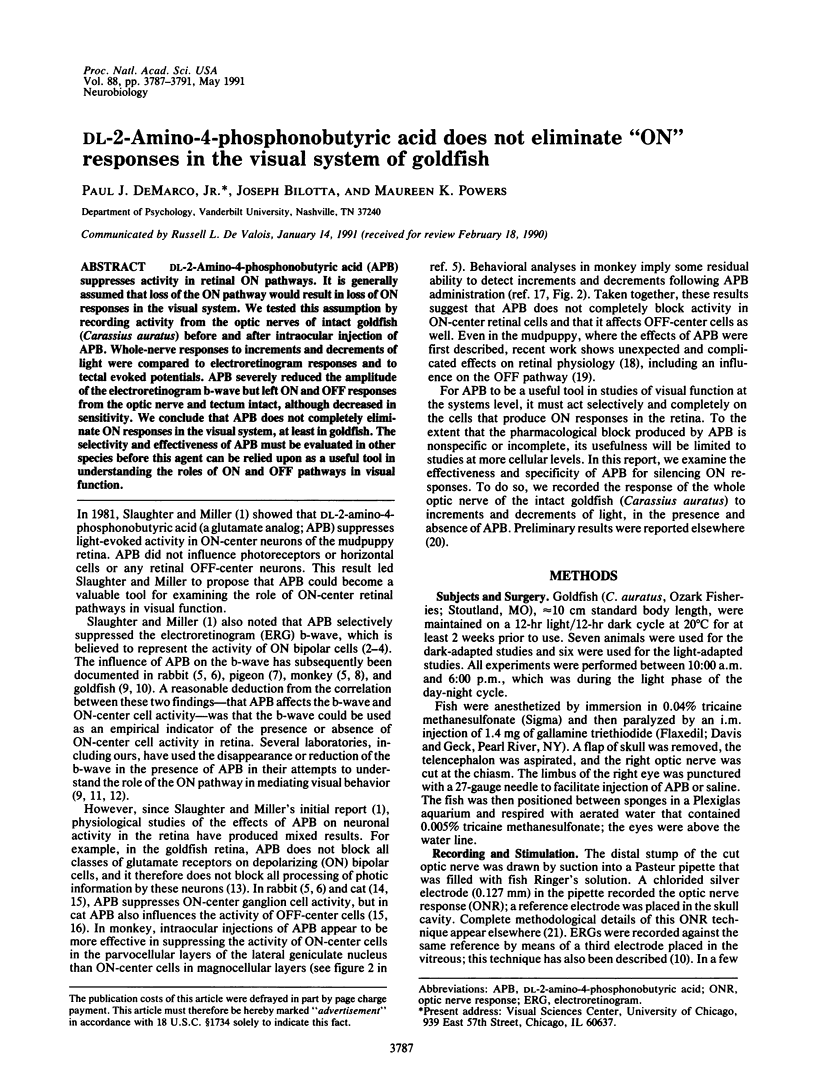
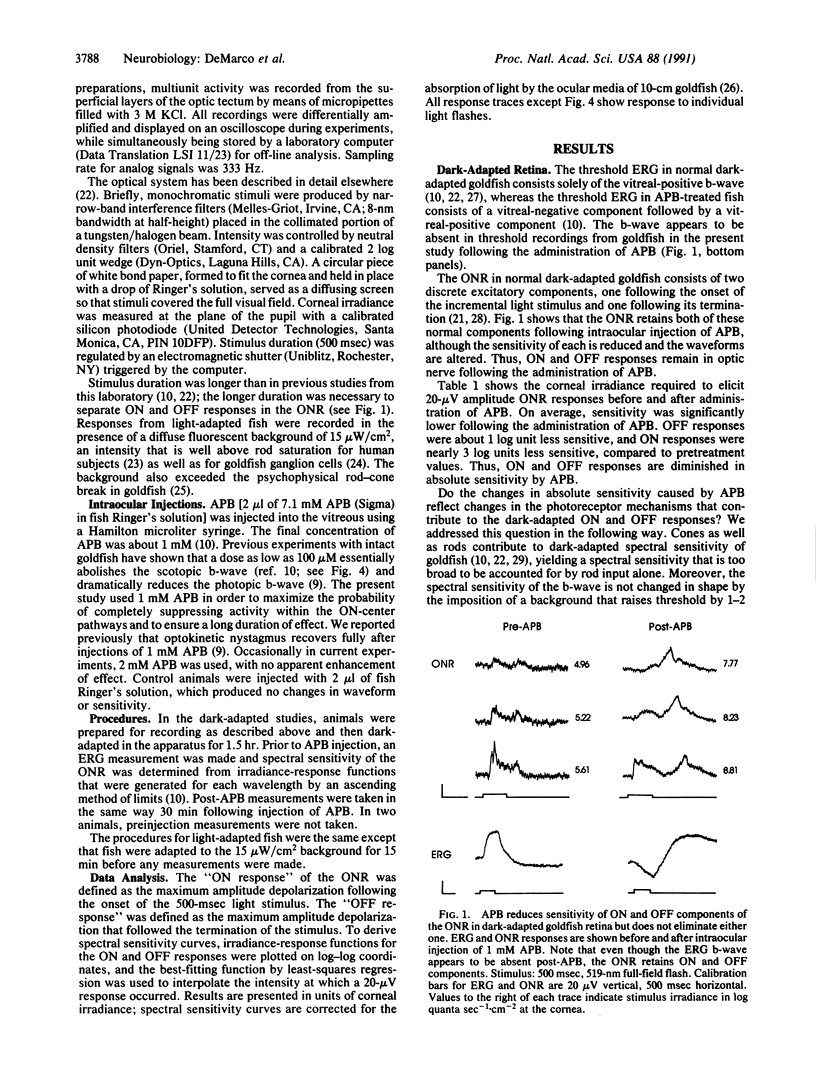
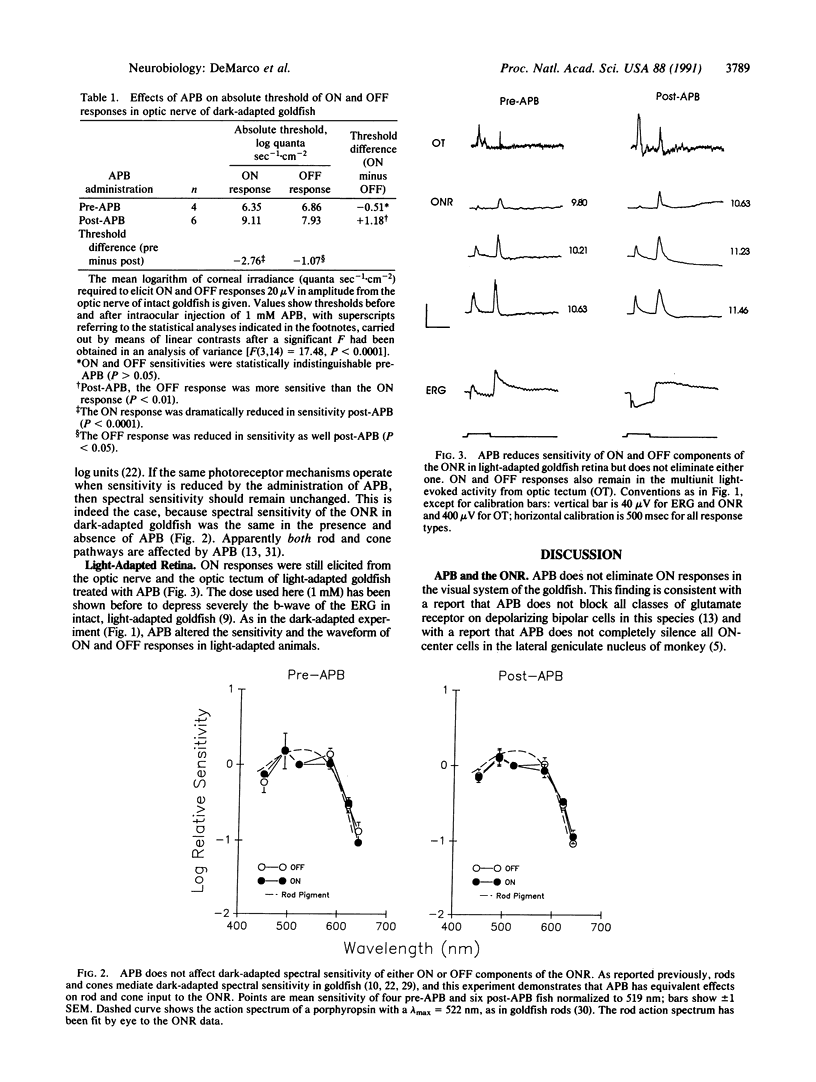
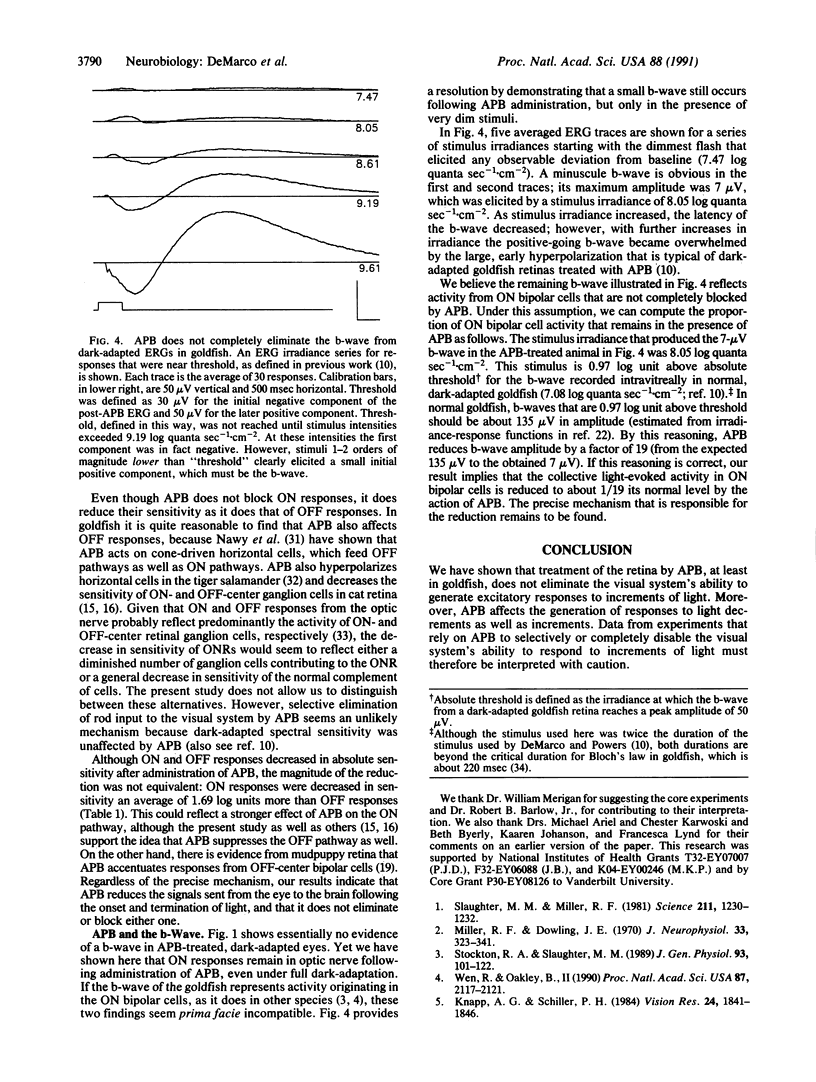
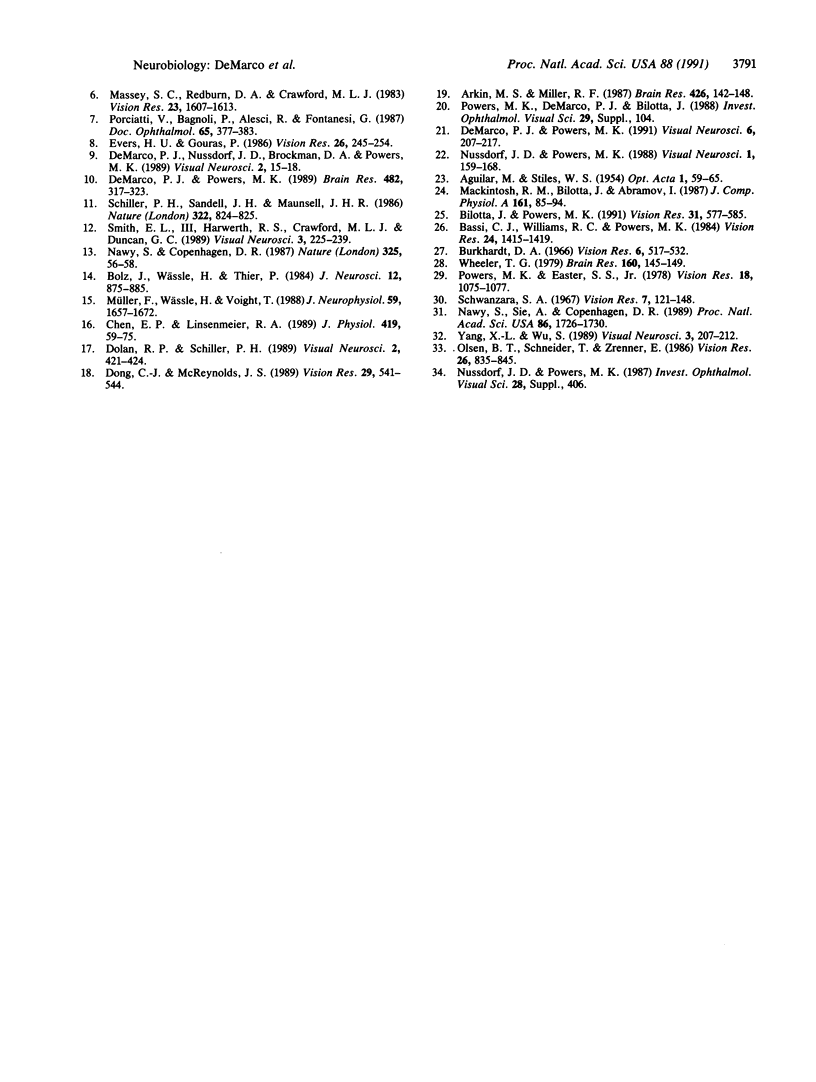
Selected References
These references are in PubMed. This may not be the complete list of references from this article.
- Arkin M. S., Miller R. F. Subtle actions of 2-amino-4-phosphonobutyrate (APB) on the Off pathway in the mudpuppy retina. Brain Res. 1987 Nov 17;426(1):142–148. doi: 10.1016/0006-8993(87)90433-1. [DOI] [PubMed] [Google Scholar]
- Bassi C. J., Williams R. C., Jr, Powers M. K. Light transmittance by goldfish eyes of different sizes. Vision Res. 1984;24(10):1415–1419. doi: 10.1016/0042-6989(84)90197-4. [DOI] [PubMed] [Google Scholar]
- Bilotta J., Powers M. K. Spatial contrast sensitivity of goldfish: mean luminance, temporal frequency and a new psychophysical technique. Vision Res. 1991;31(3):577–585. doi: 10.1016/0042-6989(91)90108-h. [DOI] [PubMed] [Google Scholar]
- Bolz J., Wässle H., Thier P. Pharmacological modulation of on and off ganglion cells in the cat retina. Neuroscience. 1984 Jul;12(3):875–885. doi: 10.1016/0306-4522(84)90176-3. [DOI] [PubMed] [Google Scholar]
- Burkhardt D. A. The goldfish electroretinogram: relation between photopic spectral sensitivity functions and cone absorption spectra. Vision Res. 1966 Oct;6(9):517–532. [PubMed] [Google Scholar]
- Chen E. P., Linsenmeier R. A. Effects of 2-amino-4-phosphonobutyric acid on responsivity and spatial summation of X cells in the cat retina. J Physiol. 1989 Dec;419:59–75. doi: 10.1113/jphysiol.1989.sp017861. [DOI] [PMC free article] [PubMed] [Google Scholar]
- DeMarco P. J., Jr, Nussdorf J. D., Brockman D. A., Powers M. K. APB selectively reduces visual responses in goldfish to high spatiotemporal frequencies. Vis Neurosci. 1989;2(1):15–18. doi: 10.1017/s0952523800004272. [DOI] [PubMed] [Google Scholar]
- DeMarco P. J., Jr, Powers M. K. Sensitivity of ERG components from dark-adapted goldfish retinas treated with APB. Brain Res. 1989 Mar 20;482(2):317–323. doi: 10.1016/0006-8993(89)91194-3. [DOI] [PubMed] [Google Scholar]
- DeMarco P. J., Jr, Powers M. K. Spectral sensitivity of ON and OFF responses from the optic nerve of goldfish. Vis Neurosci. 1991 Mar;6(3):207–217. doi: 10.1017/s0952523800006222. [DOI] [PubMed] [Google Scholar]
- Dolan R. P., Schiller P. H. Evidence for only depolarizing rod bipolar cells in the primate retina. Vis Neurosci. 1989;2(5):421–424. doi: 10.1017/s0952523800012311. [DOI] [PubMed] [Google Scholar]
- Dong C. J., McReynolds J. S. APB increases apparent coupling between horizontal cells in mudpuppy retina. Vision Res. 1989;29(5):541–544. doi: 10.1016/0042-6989(89)90040-0. [DOI] [PubMed] [Google Scholar]
- Knapp A. G., Schiller P. H. The contribution of on-bipolar cells to the electroretinogram of rabbits and monkeys. A study using 2-amino-4-phosphonobutyrate (APB). Vision Res. 1984;24(12):1841–1846. doi: 10.1016/0042-6989(84)90016-6. [DOI] [PubMed] [Google Scholar]
- Mackintosh R. M., Bilotta J., Abramov I. Contributions of short-wavelength cones to goldfish ganglion cells. J Comp Physiol A. 1987 Jun;161(1):85–94. doi: 10.1007/BF00609457. [DOI] [PubMed] [Google Scholar]
- Massey S. C., Redburn D. A., Crawford M. L. The effects of 2-amino-4-phosphonobutyric acid (APB) on the ERG and ganglion cell discharge of rabbit retina. Vision Res. 1983;23(12):1607–1613. doi: 10.1016/0042-6989(83)90174-8. [DOI] [PubMed] [Google Scholar]
- Miller R. F., Dowling J. E. Intracellular responses of the Müller (glial) cells of mudpuppy retina: their relation to b-wave of the electroretinogram. J Neurophysiol. 1970 May;33(3):323–341. doi: 10.1152/jn.1970.33.3.323. [DOI] [PubMed] [Google Scholar]
- Müller F., Wässle H., Voigt T. Pharmacological modulation of the rod pathway in the cat retina. J Neurophysiol. 1988 Jun;59(6):1657–1672. doi: 10.1152/jn.1988.59.6.1657. [DOI] [PubMed] [Google Scholar]
- Nawy S., Copenhagen D. R. Multiple classes of glutamate receptor on depolarizing bipolar cells in retina. Nature. 1987 Jan 1;325(6099):56–58. doi: 10.1038/325056a0. [DOI] [PubMed] [Google Scholar]
- Nawy S., Sie A., Copenhagen D. R. The glutamate analog 2-amino-4-phosphonobutyrate antagonizes synaptic transmission from cones to horizontal cells in the goldfish retina. Proc Natl Acad Sci U S A. 1989 Mar;86(5):1726–1730. doi: 10.1073/pnas.86.5.1726. [DOI] [PMC free article] [PubMed] [Google Scholar]
- Nussdorf J. D., Powers M. K. Spectral sensitivity of the electroretinogram b-wave in dark-adapted goldfish. Vis Neurosci. 1988;1(2):159–168. doi: 10.1017/s0952523800001437. [DOI] [PubMed] [Google Scholar]
- Olsen B. T., Schneider T., Zrenner E. Characteristics of rod driven off-responses in cat ganglion cells. Vision Res. 1986;26(6):835–845. doi: 10.1016/0042-6989(86)90142-2. [DOI] [PubMed] [Google Scholar]
- Porciatti V., Bagnoli P., Alesci R., Fontanesi G. Pharmacological dissociation of the b-wave and pattern electroretinogram. Doc Ophthalmol. 1987 Mar;65(3):377–383. doi: 10.1007/BF00149944. [DOI] [PubMed] [Google Scholar]
- Powers M. K., Easter S. S., Jr Behavioral confirmation of the "silent period" during adaptation to bright lights. Vision Res. 1978;18(8):1075–1077. doi: 10.1016/0042-6989(78)90039-1. [DOI] [PubMed] [Google Scholar]
- Schiller P. H., Sandell J. H., Maunsell J. H. Functions of the ON and OFF channels of the visual system. 1986 Aug 28-Sep 3Nature. 322(6082):824–825. doi: 10.1038/322824a0. [DOI] [PubMed] [Google Scholar]
- Schwanzara S. A. The visual pigments of freshwater fishes. Vision Res. 1967 Mar;7(3):121–148. doi: 10.1016/0042-6989(67)90079-x. [DOI] [PubMed] [Google Scholar]
- Smith E. L., 3rd, Harwerth R. S., Crawford M. L., Duncan G. C. Contribution of the retinal ON channels to scotopic and photopic spectral sensitivity. Vis Neurosci. 1989 Sep;3(3):225–239. doi: 10.1017/s0952523800009986. [DOI] [PubMed] [Google Scholar]
- Stockton R. A., Slaughter M. M. B-wave of the electroretinogram. A reflection of ON bipolar cell activity. J Gen Physiol. 1989 Jan;93(1):101–122. doi: 10.1085/jgp.93.1.101. [DOI] [PMC free article] [PubMed] [Google Scholar]
- Wen R., Oakley B., 2nd K(+)-evoked Müller cell depolarization generates b-wave of electroretinogram in toad retina. Proc Natl Acad Sci U S A. 1990 Mar;87(6):2117–2121. doi: 10.1073/pnas.87.6.2117. [DOI] [PMC free article] [PubMed] [Google Scholar]
- Wheeler T. G. Retinal ON and OFF responses convey different chromatic information to the CNS. Brain Res. 1979 Jan 5;160(1):145–149. doi: 10.1016/0006-8993(79)90609-7. [DOI] [PubMed] [Google Scholar]
- Yang X. L., Wu S. M. Effects of CNQX, APB, PDA, and kynurenate on horizontal cells of the tiger salamander retina. Vis Neurosci. 1989 Sep;3(3):207–212. doi: 10.1017/s0952523800009962. [DOI] [PubMed] [Google Scholar]


